World Journal of Nuclear Science and Technology
Vol.3 No.4(2013), Article ID:37604,5 pages
DOI:10.4236/wjnst.2013.34022
Lepton Scattering Cross Section and Nuclear Structure Function of 4He and 12C Nuclei
1Islamic Azad University, Jolfa International Branch, Jolfa, Iran
2Department of Physics, University of Mohaghegh Ardabili, Ardabil, Iran
Email: *Zolfgharpour@uma.ac.ir
Copyright © 2013 Mir Hamid Musavi et al. This is an open access article distributed under the Creative Commons Attribution License, which permits unrestricted use, distribution, and reproduction in any medium, provided the original work is properly cited.
Received June 29, 2013; revised August 7, 2013; accepted August 21, 2013
Keywords: Structure Function; Differential Cross Section; The EMC Effect
ABSTRACT
This paper is an effort to extract the structure function, the EMC ratio, and the
lepton scattering cross section in the convolution nuclear theory framework for
4He and 12C nuclei. We suppose that, in conventional approach,
based on harmonic oscillator model, one could consider for a nucleus shell different
 parameters which are associated with the square root of the mean radius of the nucleus
shells. We use GRV free nucleon structure function, which has good agreement with
the proton and neutron structure function, extracted from experimental results.
In addition, the lepton scattering cross sections of 4He and 12C
nuclei are calculated in energy higher than 1 GeV. The extracted results show good
agreement with experimental data.
parameters which are associated with the square root of the mean radius of the nucleus
shells. We use GRV free nucleon structure function, which has good agreement with
the proton and neutron structure function, extracted from experimental results.
In addition, the lepton scattering cross sections of 4He and 12C
nuclei are calculated in energy higher than 1 GeV. The extracted results show good
agreement with experimental data.
1. Introduction
One of the best methods of acquiring information about the structure of the bound
nucleons inside the nuclei is the studying of the leptons scattering from the nuclei.
This kind of scattering is due to weak electromagnetic interactions of quarks inside
nuclei which gain a great deal of momentum from transferred momentum of virtual
photon. In this process, the change of the whole structure of the nuclei is small
and ignorable. The weak interacttions do not change the structure of the nuclei,
so lepton scattering can be utilized to determine the structure of the nuclei [1].
The experimental data, obtained from the deep inelastic leptons scattering from
free and bound nucleons, have been get considerable information about the structure
function of the free and bound nucleons. This accomplishment was published in 1983
by EMC group under Aubert supervision [2]. The EMC group found out that the bound
nucleons inside the nuclei have different momentum distribution in comparison with
the free nucleons [2] there is a lot of explained theory about this difference such
as Fermi motion [3,4] and the binding energy [5,6], quark exchange effect [7], pionic
contribution [8,9], shadowing effect [10] and presence of the ∆ particles
[11]. In this paper, with considering Fermi motion and binding energy effects, which
have major roles in difference between the structure function of the free and bound
nucleons, the structure function and EMC ratio in the conventional nuclear theory
for 4He and 12C nuclei are calculated by using harmonic oscillator
model with considering different
 parameters for different shells inside the nucleus have been investigated. For calculating
the structure function and the EMC effect, we imply the GRV structure function of
free nucleon [12]. Finally, we calculate the differential cross section leptons
scattering from 4He and 12C nuclei. It is shown that the obtained
results have good agreement with experimental data.
parameters for different shells inside the nucleus have been investigated. For calculating
the structure function and the EMC effect, we imply the GRV structure function of
free nucleon [12]. Finally, we calculate the differential cross section leptons
scattering from 4He and 12C nuclei. It is shown that the obtained
results have good agreement with experimental data.
2. Convoluted Nuclear Structure Function
The structure function of nucleus in convolution model can be obtained by using the following equation [5]:
 (1)
(1)
where the first sum is over proton and neutron cases. The second sum is over the
quantum number of states. The
 is the occupation number of energy level
is the occupation number of energy level
 for proton
for proton
 and neutron
and neutron
 .
.
 is the structure function of nucleons which we have used the GRV structure function
of neutron and proton.
is the structure function of nucleons which we have used the GRV structure function
of neutron and proton.
The momentum distribution function of the nucleons inside the nucleus is given by [5]:
 (2)
(2)
where
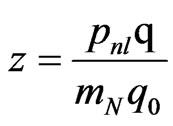 and
and
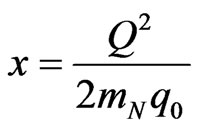 is the bjorken variable for the free nucleon. The effects of the momentum
and energy distribution of the nucleon in the nucleus are included in Equation (2)
through
is the bjorken variable for the free nucleon. The effects of the momentum
and energy distribution of the nucleon in the nucleus are included in Equation (2)
through
 and
and
 ,
respectively. The magnitude of the nuclear binding energy
,
respectively. The magnitude of the nuclear binding energy
 mainly affects the structure function in the intermediate x region. The momentum
and energy distribution of a nucleon inside a nucleus is expressed by
mainly affects the structure function in the intermediate x region. The momentum
and energy distribution of a nucleon inside a nucleus is expressed by
 that satisfies the normalization rule as below [3]:
that satisfies the normalization rule as below [3]:
 . (3)
. (3)
When the gluons and sea quark are considered, sum rule becomes as:
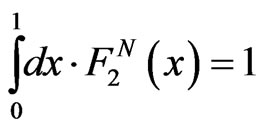 . (4)
. (4)
Equation (2) describes the momentum and energy distribution of nucleons inside nuclei.
In order to calculate
 the harmonic-oscillator nuclear wave function
the harmonic-oscillator nuclear wave function
 is used. Since in the heavy nucleus the deeper closed shells have different root
mean square radius, each shell of a nucleus has different root mean square radius
from others as [13]:
is used. Since in the heavy nucleus the deeper closed shells have different root
mean square radius, each shell of a nucleus has different root mean square radius
from others as [13]:
 , (5)
, (5)
Where
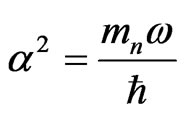 and in the natural unite, we have:
and in the natural unite, we have:
 (6)
(6)
where mn = 938.905 MeV is a nucleon mass,
 and ħ𝜔 are expressed in Fermi and MeV unit, respectively.
and ħ𝜔 are expressed in Fermi and MeV unit, respectively.
The calculated data for
 and ħ𝜔 are expressed in Table 1 for 2H, 4He and 12C
nuclei.
and ħ𝜔 are expressed in Table 1 for 2H, 4He and 12C
nuclei.

Table 1.
Brackets contain
 for studied nuclei that oscillator-model parameter
for studied nuclei that oscillator-model parameter
 calculated from Equation (6).
calculated from Equation (6).
 is taken from [14] for each shell.
is taken from [14] for each shell.
 describes the momentum distribution and energy of nucleons inside a nucleus. Instead
of using Equation (2) we use the below expression to describe the momentum distribution
and energy of the nucleons in a nucleus as [5]:
describes the momentum distribution and energy of nucleons inside a nucleus. Instead
of using Equation (2) we use the below expression to describe the momentum distribution
and energy of the nucleons in a nucleus as [5]:


 (7)
(7)
For
 we use the GRV free proton and neutron structure functions [12], and we ignore the
contribution of strange quark, the structure function of 2H, 4He
and 12C nuclei are plotted in Figure 1 based on Ref. [12].
we use the GRV free proton and neutron structure functions [12], and we ignore the
contribution of strange quark, the structure function of 2H, 4He
and 12C nuclei are plotted in Figure 1 based on Ref. [12].
3. The EMC Ratio
The experimental results showed that the structure function of a nucleus could not be obtained by summing all of the structure function of the nucleons inside the nucleus [2]. Since there are some factors like Fermi motion [3,4], binding energy [5,6], quark exchange [7], pionic contribution [8-9], and the shadowing effect [10], presence of ∆ particle [11], that cause to this difference. One of the main reasons to this difference is the Fermi motion effect that impresses the structure function of nucleus in x→1. The nuclear structure function is incoherent sum of the structure function of constituted nucleons, therefore the Fermi motion has effect on the nuclear structure function. In addition, the nuclear wave function is the convolution of the free nucleon wave function by momentum distribution of nucleon, therefore the binding energy also has effect on nuclear structure function.
To show the difference between the free nucleon with the bound nucleon inside the nucleus, the EMC ratio could be expressed as follows [2,5]:
 (8)
(8)
Figure 2
shows the EMC ratio, R(x), when Fermi motion and binding energy are considered.
When x arise to 1, it is seen that
 .
In this region, one can see that the structure function of 4He and 12C
are very small, however the structure function of free nucleon vanishes, so when
x arise to 1 the
.
In this region, one can see that the structure function of 4He and 12C
are very small, however the structure function of free nucleon vanishes, so when
x arise to 1 the
 goes to above 1. Because of the structure function of nucleus vanishes when x approach
to A (A > 1), which is atomic number of nucleus. We should remark that x is the
fraction of momentum that is carried by nucleons inside the nucleus. x > 0.8 is
the Fermi motion region, and in this region nucleons have Fermi-like motions [17,18].
goes to above 1. Because of the structure function of nucleus vanishes when x approach
to A (A > 1), which is atomic number of nucleus. We should remark that x is the
fraction of momentum that is carried by nucleons inside the nucleus. x > 0.8 is
the Fermi motion region, and in this region nucleons have Fermi-like motions [17,18].
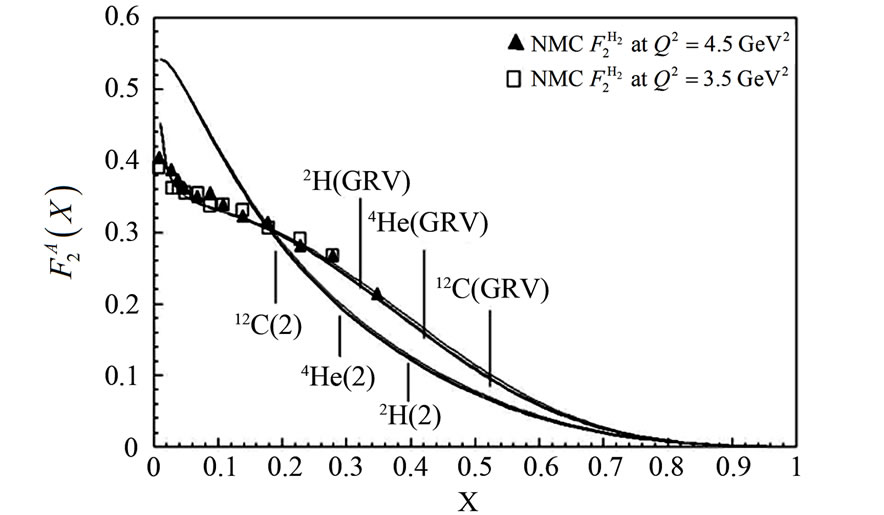
Figure 1. The structure function of 2H, 4He and 12C nuclei. In order to obtain the nucleus structure function we have used the GRV structure function of the free proton. The experimental data are taken from [15,16].
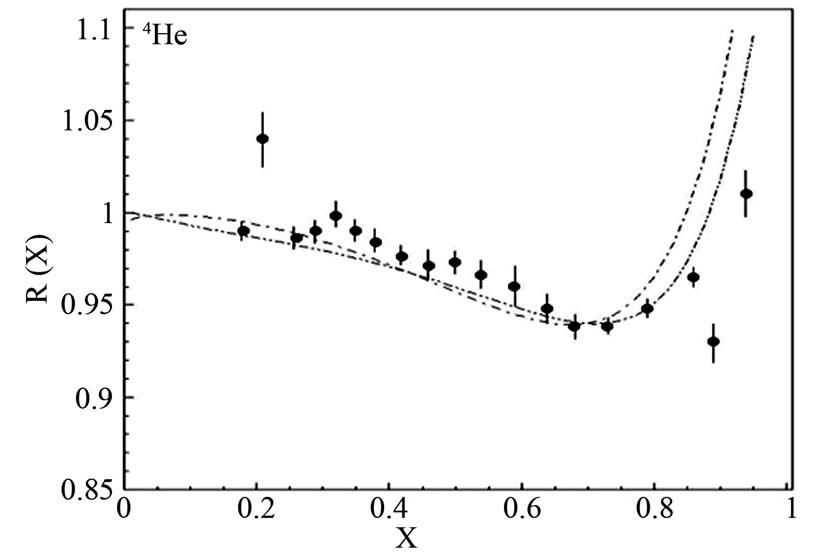 (a)
(a)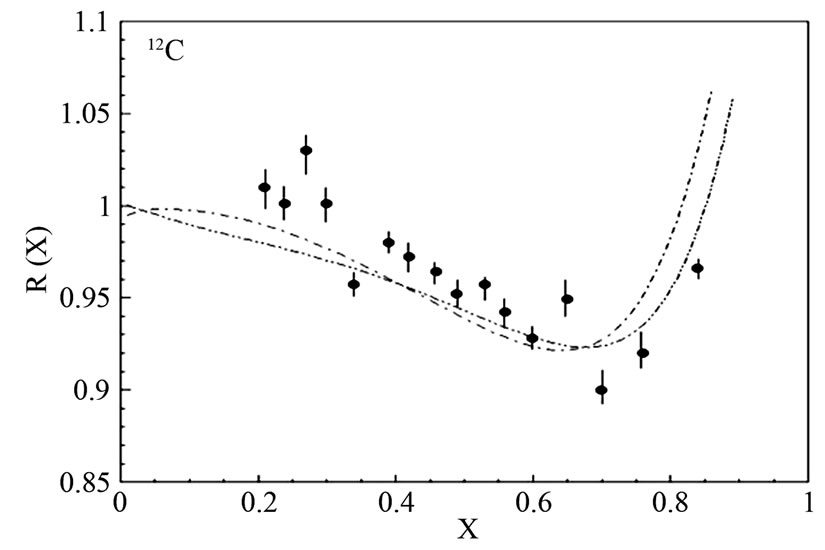 (b)
(b)
Figure 2.
The
 for 4He and 12C nuclei are plotted. We use two different nucleon
structure functions. One of them is nucleon structure function based on GRV nucleon
structure function of free proton and neutron [12] i.e. dashed and the other have
been taken from Ref. [5] i.e. dashdouble dotted.The experimental data have been
taken from Ref. [19].
for 4He and 12C nuclei are plotted. We use two different nucleon
structure functions. One of them is nucleon structure function based on GRV nucleon
structure function of free proton and neutron [12] i.e. dashed and the other have
been taken from Ref. [5] i.e. dashdouble dotted.The experimental data have been
taken from Ref. [19].
4. Deep Inelastic Scattering
Particle collision in low energy is elastic scattering; in the other word this kind of collision doesn’t produce new particles. Otherwise, if particles have enough energy when they collide to each other they create new particles. This kind of collision is called inelastic scattering. In deep inelastic scattering, the number of scattered particles with large angles demonstrates that the protons have inner structures. When leptons incident on nuclei and produce new particles, this deep inelastic scattering could be seen as the elastic scattering of leptons from nuclei constituted particles i.e. partons [20].
The differential cross section could be expressed by [21]:
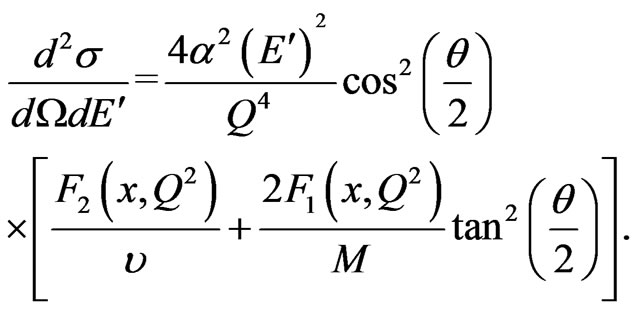 (9)
(9)
where  is the fine structure constant, four-momentum transfer squared is
is the fine structure constant, four-momentum transfer squared is
 .
Initial and scattered lepton energies are E and
.
Initial and scattered lepton energies are E and
 ,
respectively. Energy of the virtual photon is
,
respectively. Energy of the virtual photon is
 ,
and
,
and 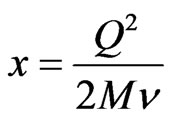 is Bjorken scaling variable. M is the nucleon rest mass.
is Bjorken scaling variable. M is the nucleon rest mass.
 is the detected lepton scattering angle. F1 and F2 are
the deep inelastic structure functions.
is the detected lepton scattering angle. F1 and F2 are
the deep inelastic structure functions.
Figure 3
shows the scattering differential cross section of leptons from the 4He
nucleus, for E = 3.595 GeV, θ = 30˚, and
 GeV2 is plotted with dashdouble-dotted, also, for θ = 29˚,
GeV2 is plotted with dashdouble-dotted, also, for θ = 29˚,
 GeV2 is plotted with dot and for θ = 27˚, and
GeV2 is plotted with dot and for θ = 27˚, and
 GeV2 show with dash-dotted as well. These curves show our main results.
Of course we should mention that, in order to obtain the results of
Figure 3(a) we have used the GRV
free nucleon structure function [12], and to obtain the results of
Figure 3(b) we have used the nucleon
structure function used in Ref. [5]. Also Figure 4 demonstrates the scattering differential
cross section of leptons from the 12C nucleus, for E = 5.86 GeV, θ =
30˚, and
GeV2 show with dash-dotted as well. These curves show our main results.
Of course we should mention that, in order to obtain the results of
Figure 3(a) we have used the GRV
free nucleon structure function [12], and to obtain the results of
Figure 3(b) we have used the nucleon
structure function used in Ref. [5]. Also Figure 4 demonstrates the scattering differential
cross section of leptons from the 12C nucleus, for E = 5.86 GeV, θ =
30˚, and
 GeV2 depicted with dash-double-dotted, and for θ = 29˚, and
GeV2 depicted with dash-double-dotted, and for θ = 29˚, and

 GeV2 depicted with dot and θ = 27˚, also for
GeV2 depicted with dot and θ = 27˚, also for
 GeV2 show with dash-dotted as well. These figures show our main results.
Of course we should mention that, in order to obtain the results of
Figure 4(a) we have used the GRV
free nucleon structure function [12], and to obtain the results of
Figure 4(b) we have used the nucleon
structure function used in Ref. [5].
GeV2 show with dash-dotted as well. These figures show our main results.
Of course we should mention that, in order to obtain the results of
Figure 4(a) we have used the GRV
free nucleon structure function [12], and to obtain the results of
Figure 4(b) we have used the nucleon
structure function used in Ref. [5].
5. Results and Discussion
Based on the calculations and comparing our results with the previous works, we conclude that nuclear interactions specially binding energy effects and the new assumptions considered in this paper can clarify both qualitatively and quantitatively the deep inelastic lepton-nuclear scattering without considering the nucleon’s quark structure changes.
 (a)
(a)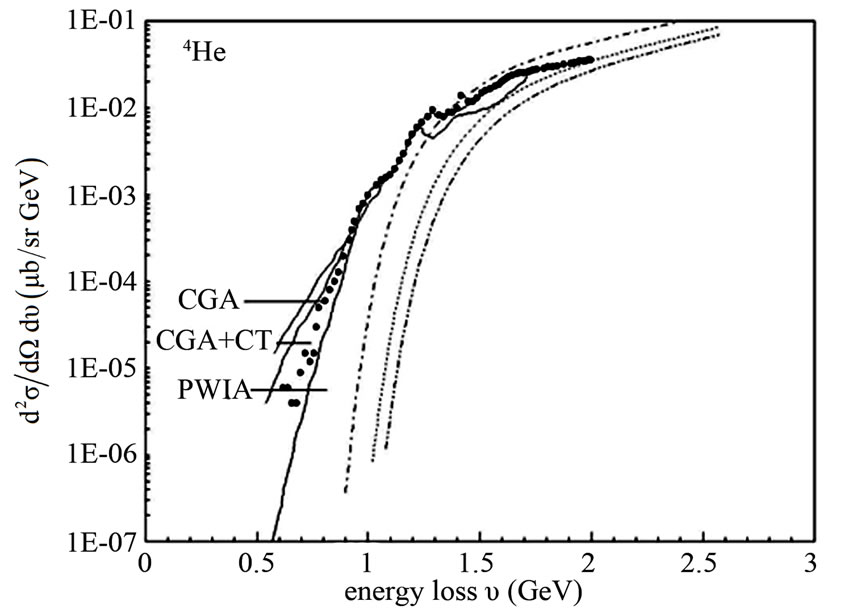 (b)
(b)
Figure 3. The (a) and (b) diagrams show the deep inelastic cross section of electron beam from 4He nuclei. We have used the GRV nucleon structure function [12] for calculation of nucleus structure function that plotted in (a) and nucleon structure function from [5] for calculating of nucleus structure function that plotted in (b) diagram. The dash-double-dotted and dot and dash-dotted cures shows our calculation. The CGA, CGA + CT, PWIA curves, and experimental data have been taken from [22].
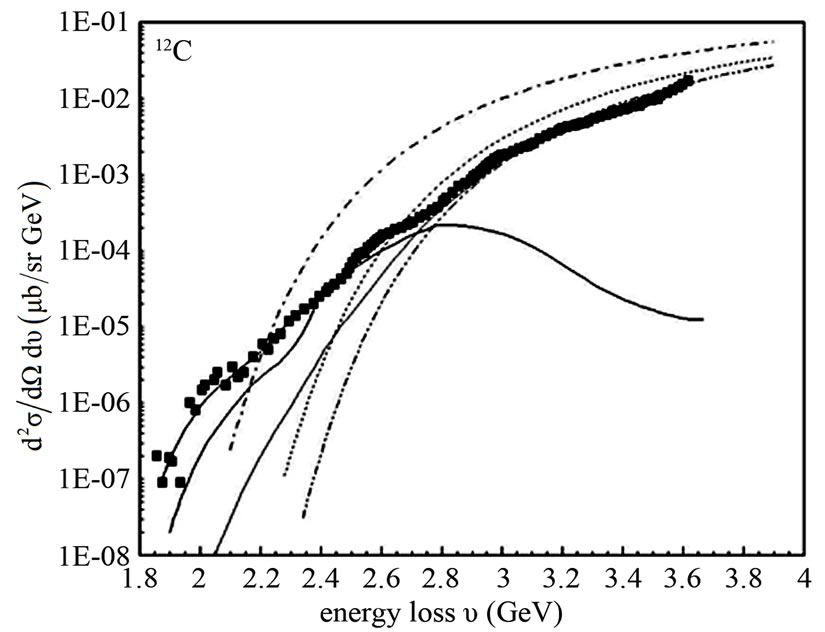 (a)
(a)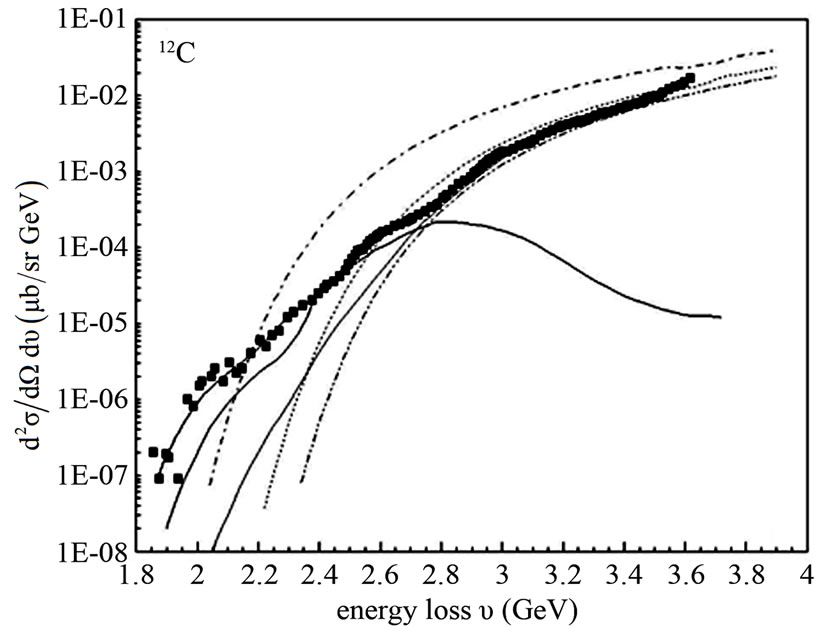 (b)
(b)
Figure 4. The (a) and (b) diagrams show the deep inelastic cross section of electron beam from 12C nuclei. We have used the GRV nucleon structure function [12] for calculation of nucleus structure function that plotted in (a) and nucleon structure function from [5] for calculating nucleus structure function that plotted in (b) diagram The dash-double-dotted and dot and dash-dotted curves shows our calculation. The three full curves and experimental data have been taken from [23].
The obtained results in Figures 2-4 are slightly different from experience or are located in experimental error domain, which are due to cloud meson, shadow effect, delta particle and other nuclear effects, which are neglected in this paper.
REFERENCES
- S. D. Drell and T. M. Yan, “Connection of Elastic Electromagnetic Nucleon Form Factors at Large Q2 and Deep Inelastic Structure Functions near Threshold,” Physics Review Letters, Vol. 24, No. 4, 1970, pp. 181-186. http://dx.doi.org/10.1103/PhysRevLett.24.181
- J. J. Aubert, G. Bassompierr, K. H. Becks, C. Best, E. Böhm, X. de Bouard, F. W. Brasse, et al., “The Ratio of the Nucleon Structure Functions F2N for Iron and Deuterium,” Physics Letters B, Vol. 123, No. 3-4, 1983, pp. 275-277. http://dx.doi.org/10.1016/0370-2693(83)90437-9
- W. B. Atwood and G. B. West, “Extraction of Asymptotic Nucleon Cross Sections from Deuterium Data,” Physical Review D, Vol. 7, No. 3, 1973, pp. 773-783. http://dx.doi.org/10.1103/PhysRevD.7.773
- A. Bodek and J. L. Ritchie, “Fermi-Motion Effects in DeepInelastic Lepton Scattering from Nuclear Targets,” Physical Review D, Vol. 23, No. 5, 1981, pp. 1070-1091. http://dx.doi.org/10.1103/PhysRevD.23.1070
- S. V. Akulinichev, S. Shlomo, S. A. Kulagin and G. M. Vagradov, “Lepton-Nucleus Deep-Inelastic Scattering” Physical Review Letters, Vol. 55 No. 21, 1985, pp. 2239- 2241. http://dx.doi.org/10.1103/PhysRevLett.55.2239
- S. V. Akulinichev, S. A. Kulagin and G. M. Vagradov, “The Role of Nuclear Binding in Deep Inelastic LeptonNucleon Scattering,” Physics Letters B, Vol. 158, No. 6, 1985, pp. 485-488. http://dx.doi.org/10.1016/0370-2693(85)90799-3
- P. Hoodbhoy and R. L. Jaffe, “Quark Exchange in Nuclei and the European Muon Collaboration Effect,” Physical Review D, Vol. 35, No. 1, 1987, pp. 113-121. http://dx.doi.org/10.1103/PhysRevD.35.113
- T. Uchiyama and K. Saito, “European Muon Collaboration Effect in Deuteron and in Three-Body Nuclei,” Physical Review C, Vol. 38, No. 5, 1988, pp. 2245-2250. http://dx.doi.org/10.1103/PhysRevC.38.2245
- E. L. Berger and F. Coester, “Nuclear Effects in DeepInelastic Lepton Scattering,” Physical Review D, Vol. 38, No. 5, 1985, pp. 1071-1083. http://dx.doi.org/10.1103/PhysRevD.32.1071
- L. L. Frankfurt and M. I. Strikman, “High-Energy Phenomena, Short-Range Nuclear Structure and QCD,” Physics Reports, Vol. 76, No. 4, 1981, pp. 215-347. http://dx.doi.org/10.1016/0370-1573(81)90129-0
- G. Cattapan and L. Ferreira, “The Role of Δ in Nuclear Physics,” Physics Report, Vol. 362, No. 5-6, 2002, pp. 303-407. http://dx.doi.org/10.1016/S0370-1573(01)00093-X
- M. Gluck, E. Reya and A. Vogt, “Dynamical Parton Distributions of Parton and Small-x Physics,” Z Physics C, Vol. 67, No. 3, 1995, pp. 433-447. http://dx.doi.org/10.1007/BF01624586
- M. A. Preston and R. K. Bhaduri, “Structure of Nucleus,” Addison-Wesley Publishing Company, 1982.
- R. C. Barratt and D. F. Jackson, “Nuclear Sizes and Structure,” Oxford University Press, Oxford, 1977.
- M. Arneodo, A. Arvidson, B. Badełek, M. Ballintijn, G. Baum, J. Beaufays, et al., “Measurement of the Proton and Deuteron Structure Functions, Fp2 and Fd2, and of the Ratio σL/σT,” Nuclear Physics B, Vol. 483, No. 1-2, 1997, pp. 3-43. http://dx.doi.org/10.1016/S0550-3213(96)00538-X
- K. Ackerstaff, A. Airapetian, N. Akopov, I. Akushevich, M. Amarian, E. C. Aschenauer, et al., “Nuclear Effects on R = σL/σTin Deep-Inelastic Scattering,” Physics Letters B, Vol. 475, No. 3-4, 2000, pp. 386-394. http://dx.doi.org/10.1016/S0370-2693(99)01493-8
- M. Arneodo, “Nuclear Effects in Structure Functions,” Physics Reports, Vol. 240, No. 5-6, 1990, pp. 301-393. http://dx.doi.org/10.1016/0370-1573(94)90048-5
- D. F. Geesaman, K. Saito and A. W. Thomas, “The Nuclear EMC Effect,” Annual Review Nuclear Particle Science, Vol. 45, No. 1, 1995, pp. 337-390. http://dx.doi.org/10.1146/annurev.ns.45.120195.002005
- R. G. Arnold, P. E. Bosted, C. C. Chang, J. Gomez, A. T. Katramatou, G. G. Petratos, et al., “Measurements of the A Dependence of Deep-Inelastic Electron Scattering from Nuclei,” Physics Review Letters, Vol. 52, No. 9, 1984, pp. 727-730. http://dx.doi.org/10.1103/PhysRevLett.52.727
- S. D. Drell and J. D. Walecka, “Electrodynamic Processes with Nuclear Targets,” Annals Physics, Vol. 28, No. 1, 1964, pp. 18-33. http://dx.doi.org/10.1016/0003-4916(64)90141-1
- J. Gomez, R. G. Arnold, P. E. Bosted, C. C. Chang, A. T. Katramatou, G. G. Petratos, et al., “Measurement of the A Dependence of Deep-Inelastic Electron Scattering,” Physical Review D, Vol. 49, No. 9, 1994, pp. 4348-4372. http://dx.doi.org/10.1103/PhysRevD.49.4348
- O. Benhar and V. R. Pandharipande, “Scattering of GeVElectrons by Light Nuclei,” Physical Review C, Vol. 47, No. 5, 1993, pp. 2218-2227. http://dx.doi.org/10.1103/PhysRevC.47.2218
- D. Day, “Scaling and Short Range Correlations in Inclusive Electron-Nucleus Scattering at High Momentum Transfers,” 6th International Conference on Perspective in Hadronic Physics ICTP, Trieste, 12-16 May 2004.
NOTES
*Corresponding author.

